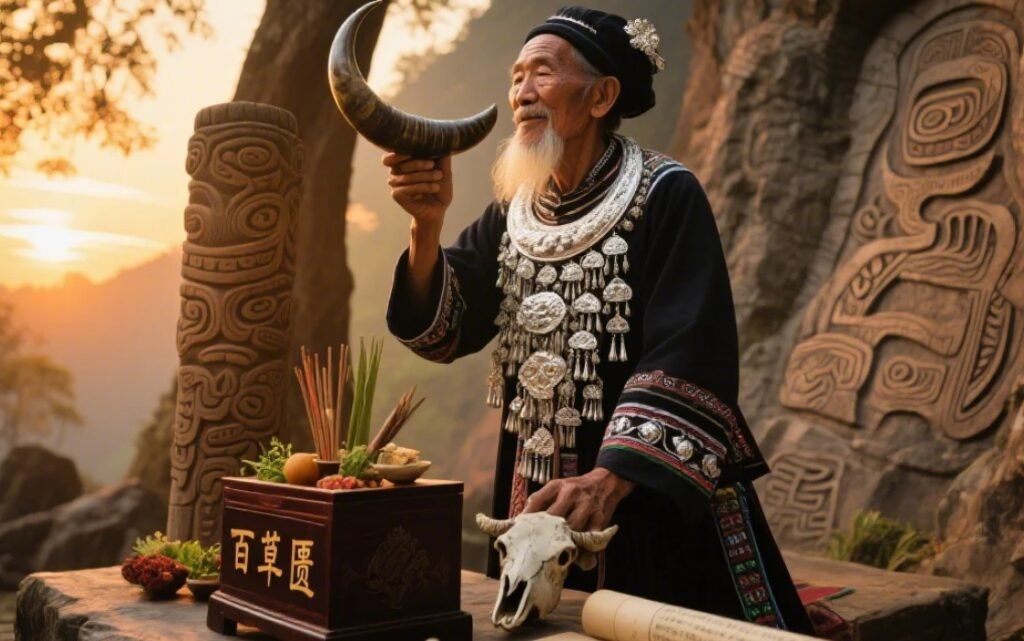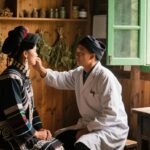Geji Chuorou (Cholelithiasis)
Overview
In Miao medicine, cholelithiasis is known as Geji Chuorou, a condition that falls under liver framework disorders. It is a chronic disease characterized by varying degrees of pain in the liver area, such as dull pain, stabbing pain, severe pain, or colicky pain. It is often accompanied by symptoms like chest tightness, abdominal bloating, irritability, and emotional agitation. The causes include emotional distress, external damp-heat invasion, overexertion, or dietary damage.
From the perspective of Traditional Chinese Medicine (TCM), the fundamental pathogenesis of cholelithiasis involves disharmony in the liver collaterals and accumulation of damp-heat. The main pathogenic factors include qi stagnation, blood stasis, and damp-heat. Excess patterns are commonly caused by liver qi stagnation and damp-heat accumulation, while deficiency patterns arise from insufficient yin and blood, leading to poor nourishment of the liver collaterals. In TCM, this condition belongs to the category of “hypochondriac pain.”
Western medicine defines cholelithiasis as gallstone formation, which may result from impaired bile excretion, bile stasis and crystallization, or inflammation and malformation of the biliary tract. Any condition involving stones in the biliary system may refer to this disease for differential diagnosis and (used in traditional contexts).
Huhou Jipeng (Miao Medicine Syndromes)
Geji Chuorou arises from emotional disturbance, external damp-heat, excessive labor, or dietary injury. It is considered a minor condition and is divided into two subtypes: cold-channel Geji Chuorou and hot-channel Geji Chuorou. In the early stages, the disease is mild and classified as cold-channel Geji Chuorou. As symptoms worsen, it is regarded as hot-channel Geji Chuorou.

Aijiangduo (Etiology)
Miao medicine believes that the onset of this condition is closely related to factors such as emotional frustration, invasion of damp-heat pathogens, improper diet, and chronic fatigue or illness. These internal and external causes damage the liver framework, leading to stagnation of qi flow and internal accumulation of damp-heat. This results in abnormal bile secretion and circulation. Over time, pathological fluids and blood congeal into stones, blocking the bile duct and manifesting as Geji Chuorou.
Gengduomeng (Pathogenesis)
This disease results from multiple causes that impair the liver framework, disrupt the bile drainage, and lead to the congealing of blood and fluids into stones within the bile ducts. Common symptoms include pain in the liver area, fatigue, irritability, poor appetite, bitter taste in the mouth, and dry throat. The disease is primarily located in the liver framework and is closely related to injuries involving qi, blood, and fluids.
Diagnostic Points
Diagnostic Criteria
Pain in the liver area is the primary clinical manifestation, with various pain types such as dull, stabbing, or distending pain, occurring irregularly.
Accompanying symptoms may include chest tightness, abdominal bloating, irritability, bitter taste in the mouth, and dry throat.
Often a history of emotional upset, dietary irregularities, or prolonged overwork is present.
Relevant Examinations
Routine blood tests, coagulation panels, liver function tests, X-ray imaging, liver ultrasound, and CT scan can assist in preliminary screening. Liver biopsy and immunological testing may help confirm the diagnosis.
Differential Diagnosis
Pugaqiu (Abdominal Distension and Ascites)
Both Geji Chuorou and Pugaqiu can involve pain in the liver framework region. Geji Chuorou is characterized by dull, stabbing, severe, or colicky pain in the liver area due to emotional disturbances, damp-heat invasion, excessive labor, or dietary injury. Pugaqiu, on the other hand, is caused by water-damp retention, initially presenting with pain under the ribs and abdominal distension that worsens after meals. As the disease progresses, abdominal swelling becomes more pronounced, with symptoms such as sallow complexion, fatigue, poor appetite, visible abdominal veins, emaciation of the limbs, lower limb edema, urinary difficulty, and in severe cases, bleeding tendencies.
Syndrome Differentiation and Treatment
Cold-Channel Geji Chuorou
Manifestations: In the early stage, symptoms are not obvious and may be entirely absent. Liver function tests may be normal or only mildly abnormal. Patients may experience occasional dull pain or distension in the liver area, bitter taste in the mouth, poor appetite, and nausea.
Channel Classification: Belongs to cold-channel, cold-disease type.
Treatment Principle: Clear heat and eliminate dampness.
Prescription:
Endothelium corneum gigeriae galli (jineijin) 30g
Lysimachia christinae (jinqiancao) 50g
Japanese climbing fern spore (haijinsha) 25g
Oldenlandia (baihuasheshecao) 25g
Lygodium root (wo liao) 15g
Achyranthes bidentata (niuxi) 15g

Explanation:
Chicken gizzard lining is warm and salty, belongs to hot herbs, enters cold channel, and dissolves stones and promotes urination.
Gold coin grass is cold, bitter, and slightly sweet; it clears heat and toxins, promotes urination, invigorates blood, and reduces swelling.
Spreading hedyotis is cold and bitter; it clears heat and toxins, promotes urination, and resolves blood stasis.
Japanese goldthread is cold and bitter; it promotes urination and clears heat.
Lygodium root is cold, bitter, and slightly sweet; it promotes urination, cools blood, and clears damp-heat.
Achyranthes root is cold, sour, and bitter; it invigorates blood, reduces dampness, and promotes urination.
Hot-Channel Geji Chuorou
Manifestations: In later stages, symptoms worsen with upper abdominal or liver area pain that may be colicky, severe, or intermittent. It may be accompanied by vomiting, radiating pain to the right back, restlessness, chills, and high fever.
Channel Classification: Belongs to hot-channel, hot-disease type.
Treatment Principle: Expel stones and promote urination.
Prescription:
Alternanthera philoxeroides (soudangsuo) 20g
Prunus mume (wumei) 50g
Phellodendron chinense (huangbo) 10g
Dianthus superbus (qumai) 10g
Endothelium corneum gigeriae galli (jineijin) 30g
Explanation:
Four-season red is warm, slightly bitter, and astringent; it clears heat, invigorates blood, and dissolves stasis.
Chinese plum is cold and sour; it moistens the lungs, strengthens the spleen, reduces accumulations, clears heat, quenches thirst, and calms irritability.
Phellodendron bark is cold and bitter; it clears heat, drains fire, and dries dampness.
Dianthus flower is cold and bitter; it promotes urination and resolves damp-heat.
Chicken gizzard lining dissolves stones and promotes urination.
Preventive Care
Maintain emotional balance and avoid excessive worry.
Protect against cold and dress appropriately for the weather.
Eat a balanced diet and avoid alcohol and tobacco.
Maintain regular routines and balance work with rest.
Remarks
In Miao medicine, the liver framework is regarded as a vital part of the body with significant coordinating functions over other organs. It is also seen as the source of qi and blood for the entire body. Disorders like Geji Chuorou arise from emotional disruption, external damp-heat, overwork, or dietary harm. Symptoms include pain of various types in the liver region, chest tightness, abdominal bloating, and irritability. Liver framework disorders may also affect the function of other organs, making early (used in traditional contexts) essential. Therapeutic strategies focus on clearing heat, draining dampness, and dissolving stones.


Leave a Reply